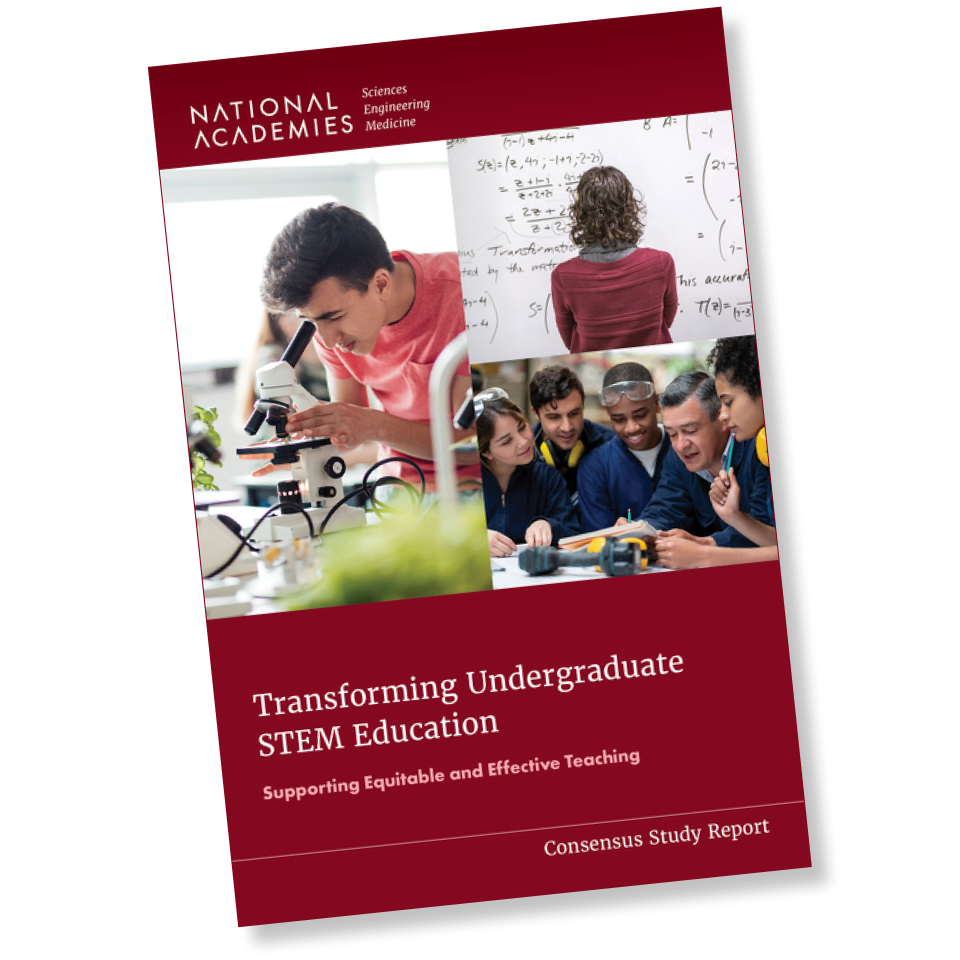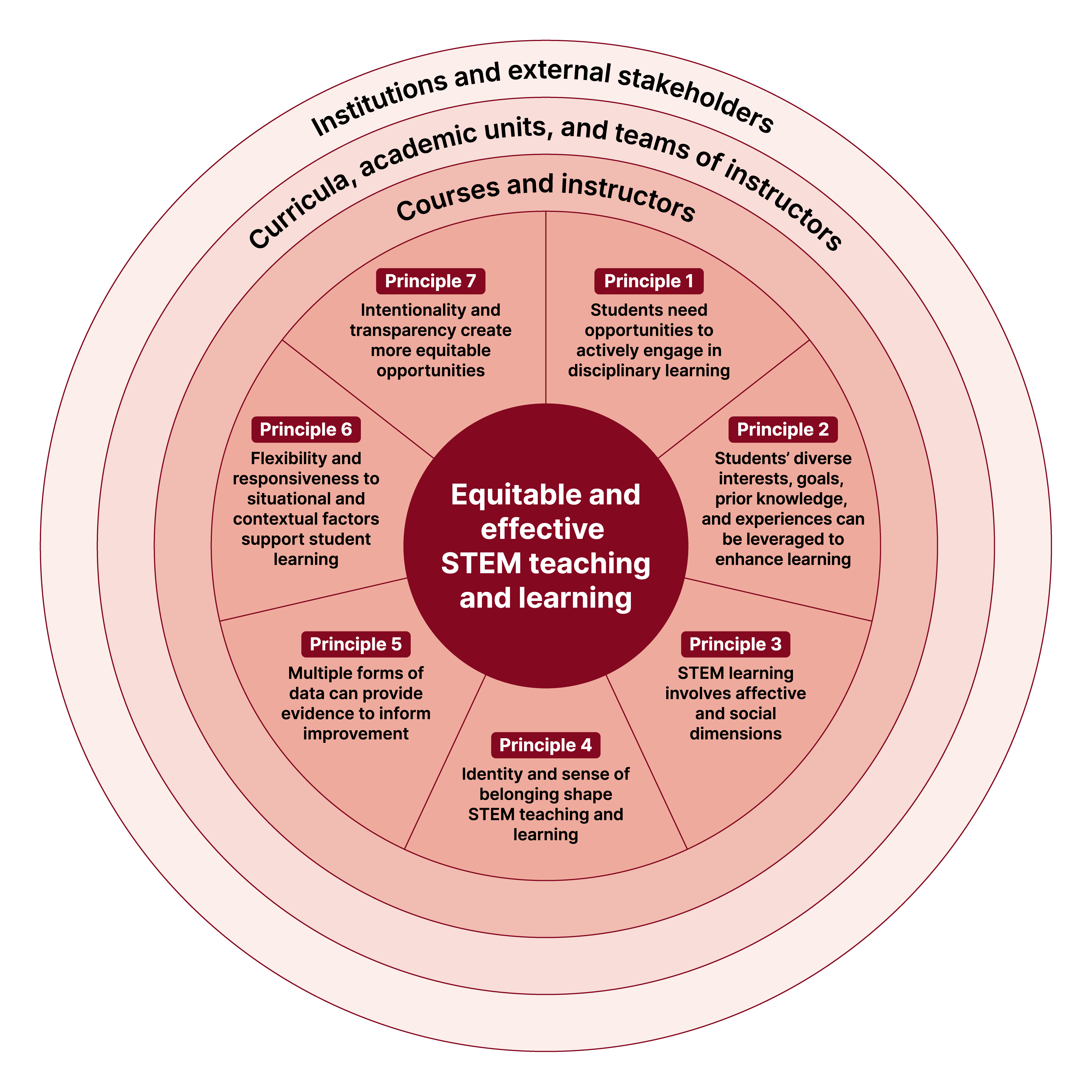
Transforming Undergraduate STEM Education
Supporting Equitable and Effective Teaching

Summary
Transforming Undergraduate STEM Education: Supporting Equitable and Effective Teaching (2025), published by the National Academies of Sciences, Engineering, and Medicine, offers a comprehensive framework for strengthening undergraduate STEM instruction. The report emphasizes that transforming STEM education requires sustained action across institutions, academic departments, and individual educators—and must be grounded in a commitment to student learning, equity, and evidence. It identifies persistent barriers and structural challenges while offering a clear path forward, anchored by a set of seven core principles (Chapter 4, pp. 70–97).
These seven principles offer a research-based foundation for improving undergraduate STEM education. Together, they describe the conditions necessary to support student learning and success, centering what students need to thrive and what instructors, departments, and institutions can do to make that possible. Grounded in decades of learning research, the principles are designed to inform decisions at every level, from classroom teaching to system-wide change. The graphic below offers an overview of the principles at the core of the report’s framework.

Who is this report for?

This report is designed for anyone working to improve undergraduate STEM instruction, including:
- Postsecondary instructors
- Department chairs and program leaders
- Centers for teaching and learning (CTLs)
- Deans, provosts, and institutional leaders
- Policy makers and grant-makers focused on student success and equity in STEM
- Oversight bodies and professional, academic, and disciplinary associations
- Instructional materials developers and professional learning providers
Users of this report can implement the seven principles to strengthen undergraduate STEM education at every level. Whether guiding course design, shaping professional learning, or driving system-wide change, the principles support efforts to improve student outcomes and advance equity—particularly for those historically excluded from STEM.
How the 8 Digitally-Enabled, Evidence-Based Teaching Practices Align with the 7 NASEM Principles

On this website, Every Learner Everywhere presents 8 digitally-enabled, evidence-based teaching practices that offer concrete, research-backed strategies for bringing the 7 NASEM principles to life in classrooms and departments. These practices provide actionable ways to scale learner-centered and effective teaching through digital tools and technology.
Both sets of practices and principles are grounded in a shared commitment to transforming undergraduate STEM education. Their distinct emphases and language reflect complementary perspectives. Taken together, they offer a more complete and actionable vision for supporting all students, particularly those historically excluded from STEM. This crosswalk illustrates how the NASEM principles and the digitally-enabled, evidence-based teaching practices work in tandem.
Actionable Strategies
There are actionable strategies available for implementing both the digitally-enabled, evidence-based teaching practices and the seven NASEM principles.
You can explore real course examples for the teaching practices in the Example Library on this site.
You can find recommended actions aligned to the NASEM principles in the full report, particularly in Chapter 4 (pp. 70–97) and Chapter 5 (pp. 98–135).
Principle 1
Students need opportunities to actively engage in disciplinary learning.
Principle 3
STEM learning involves affective and social dimensions.
Designing opportunities for students to actively work through disciplinary challenges, both individually and in groups, helps foster engagement and build classroom cultures where all students can contribute and succeed.
Principle 2
Students’ diverse interests, goals, knowledge, and experiences can be leveraged to enhance learning
Recognizing and drawing on students’ existing knowledge helps personalize instruction and create learning environments where all students can access and build on core concepts. Intentionally connecting STEM content to students’ interests and providing opportunities for them to connect their familial and community experiences to STEM can increase motivation and engagement, and promote persistence
Principle 5
Multiple forms of data can provide evidence to inform improvement.
Using disaggregated student data to inform teaching decisions helps address instructional strengths and barriers, and improve the responsiveness of instruction.
Principle 5
Multiple forms of data can provide evidence to inform improvement.
Principle 6
Flexibility and responsiveness to situational and contextual factors support student learning.
Immediate and Ongoing feedback loops allow instructors to adjust their teaching in real time and help students monitor their own progress.
Effective instruction adapts to dynamic contexts while maintaining high expectations and clear learning goals.
Principle 4
Identity and sense of belonging shape STEM teaching and learning.
Principle 2
Students’ diverse interests, goals, knowledge, and experiences can be leveraged to enhance learning.
Creating environments where students feel seen, respected, and connected supports persistence and engagement, especially for those historically excluded from STEM fields.
Learning environments that acknowledge and build upon students’ existing knowledge foster deeper connections to the material and enhance engagement.
Principle 7
Intentionality and transparency create more equitable opportunities
Clarifying expectations, grading criteria, and learning processes helps reduce ambiguity and support classroom environments where students understand how to succeed and what is expected of them.
Principle 1
Students need opportunities to actively engage in disciplinary learning.
Principle 3
STEM learning involves affective and social dimensions.
Helping students reflect on their thinking and learning supports metacognitive development and empowers them to take intentional action, revise strategies, and take ownership of their progress.
Helping students feel safe, seen, and supported strengthens their ability to focus, persist, and engage fully in learning.
Principle 1
Students need opportunities to actively engage in disciplinary learning.
Principle 3
STEM learning involves affective and social dimensions.
Principle 4
Identity and sense of belonging shape STEM teaching and learning.
Structured opportunities to work with peers through active learning builds community, strengthens problem-solving skills, and fosters learning environments where all students can contribute meaningfully to group work.
Opportunities for social interaction can help students reflect on their current understanding, identify areas where they may have misunderstandings, construct shared meaning based on their own experiences, and develop a sense of belonging to the STEM community.
About NASEM
The National Academies of Sciences, Engineering, and Medicine are private, nonprofit institutions that provide independent, objective advice to inform policy and advance the public good. The Academies marshal top experts across disciplines to examine complex issues, shape research agendas, and offer evidence-based guidance on challenges facing the nation and the world.
This report was developed under the guidance of the Board on Science Education (BOSE), part of the National Academies’ Division of Behavioral and Social Sciences and Education. BOSE works to strengthen STEM education by convening educators, researchers, and institutional leaders to explore effective teaching practices, support inclusive learning environments, and promote systemic change across higher education.
Transforming Undergraduate STEM Education
Supporting Equitable and Effective Teaching








